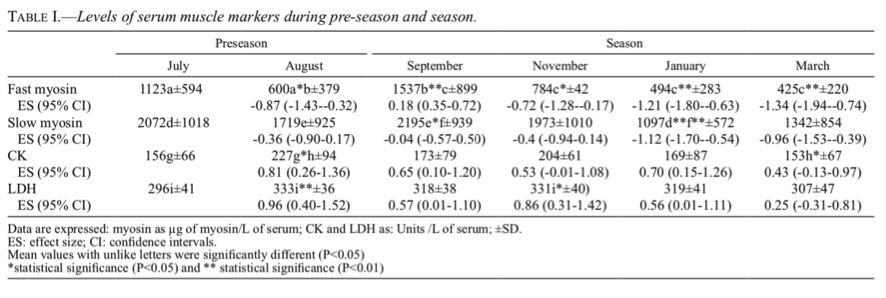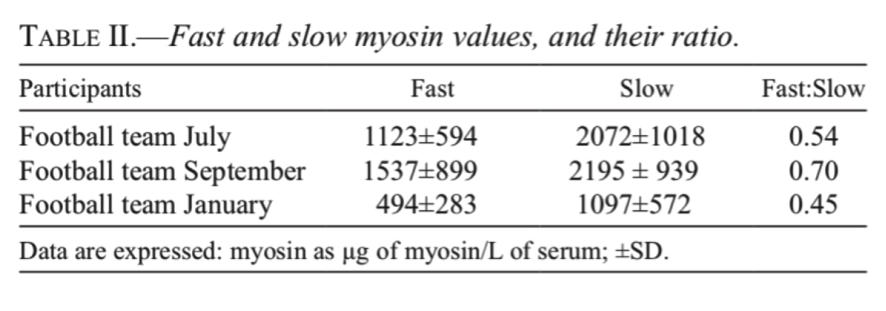October 1, 2020
Injury Management
Health and Wellness
Sports Performance
A new tool to control muscle load in football players
Professional football players have some particular physiological characteristics which allow them to run an average of 10-12 km per match as well as reaching speeds above 30 km/h. This makes those muscle groups with higher involvement in acceleration and deceleration scenarios (such as the hamstrings) be more susceptible to injury (they represent 12-16 % of total injuries).
One of the reasons why this area is more sensitive to getting injured could be related to the composition of its muscle fibres. The hamstrings have a high proportion of type II fibres, also called fast fibres,1 and due to structural and metabolic differences with respect to type I fibres, make them more vulnerable to damage from mechanical stress.2 That’s why if we know how these types of muscle fibre respond to workload, it could help prevent injuries.
Traditional blood tests which measure biomarkers, such as creatine kinase (CK), relate muscle response (specifically, muscle damage) to training load in football players,3 but the information it provides is limited and its reading does not differentiate between the types of fibre. A new study performed by researchers from the University of Barcelona,4 has shown how the concentration of fast and slow isoforms of myosin in blood could be a reliable marker for exercise-induced muscle damage, as well as being capable to differentiate by fibre type. Following this study, fast myosin isoform would be a characteristic of type II fibres, while the slow ones are type I fibres. Carmona et al. have seen that after an exercise with a high eccentric component, performed with an isoinertial device, the levels of fast myosin increase, while in endurance sports, such as an ultra-marathon, the levels of slow isoform increase; thus, this technique can distinguish between types of fibres and sports specialisation.5,6
It is well worth to highlight that isoform analysis can be sensitive when detecting first-degree muscle strains (small fibres breaking) that are difficult to diagnose through magnetic resonance imaging or ultrasound. Another aspect to have in consideration is that the traditional laboratory technique (Western blot) used to analyse myosin isoforms, is slow and not very sensitive, so it is not possible to implement it in a practical way for elite sports.
For this reason, research performed by members of FC Barcelona and the University of Barcelona,7 have used a faster and more precise technique (ELISA), rather than the traditional methods, by measuring myosin levels in the blood for Sporting de Gijón club throughout a season. Also, the concentrations of CK and lactate dehydrogenase (LDH) were measured in order to compare the evolution of myosin with that of biomarkers traditionally used for monitoring players.

The behaviour pattern of both fast and slow myosin along the season was similar (table 1). In the first month of the preseason, the concentrations decreased (August) and increased significantly at the beginning of the season (September), coinciding with the increase in physical load. This increase was not quantitatively the same, as these types of fiber were damaged to different degrees, as indicated by the ratio in table II (which shows a greater damage of the fast ones). Afterwards, the levels of both isoforms decreased significantly despite the fact that the training load was maintained, indicating a muscular adaptation to training.

In turn, CK and LDH behaviour was different. The CK and LDH values showed an increase at the beginning of the preseason and returned to basal levels along the preseason. In this case, it seems that these are the first serum markers to appear when the muscular workload is increased, reflecting an inflammatory process located in the fibre membrane before the disruption of the fibre itself. If its structure is completely damaged, myosin would be released into the blood, a process that could already be measured with myosin isoforms.
Therefore, measuring the serum levels of myosin isoforms can be a new procedure to help improve the monitoring process for training sessions and the competition. The researchers claim that “it is possible to detect alterations in the structure of the sarcomere”, which could help prevent more damage during the season. In the near future, if blood sample analysis times are shortened, the impact of training and competition on each type of fibre could be identified, helping to control the damage and thus avoiding second and third-degree progression that wouldn´t allow players to compete.
BIHUB team
References:
- Garrett WE, Califf JC, Bassett FH. Histochemical correlates of hamstring injuries. Am J Sports Med. 1984;12(2):98-103. doi:10.1177/036354658401200202
- Qaisar R, Bhaskaran S, Van Remmen H. Muscle fiber type diversification during exercise and regeneration. Free Radic Biol Med. 2016;98:56-67. doi:https://doi.org/10.1016/j.freeradbiomed.2016.03.025
- Nédélec M, McCall A, Carling C, Legall F, Berthoin S, Dupont G. Recovery in soccer. Sport Med. 2012;42(12):997-1015.
- Guerrero M, Guiu-Comadevall M, Cadefau JA, et al. Fast and slow myosins as markers of muscle injury. Br J Sports Med. 2008;42(7):581 LP – 584. doi:10.1136/bjsm.2007.037945
- Carmona G, Guerrero M, Cussó R, et al. Muscle enzyme and fiber type-specific sarcomere protein increases in serum after inertial concentric-eccentric exercise. Scand J Med Sci Sports. 2015;25(6):e547-e557. doi:10.1111/sms.12363
- Carmona G, Roca E, Guerrero M, et al. Sarcomere Disruptions of Slow Fiber Resulting From Mountain Ultramarathon. Int J Sports Physiol Perform. 2015;10(8):1041-1047. doi:10.1123/ijspp.2014-0267
- Guerrero M, Carmona G, Rodas G, Cadefau JA, Maestro A, Cusso R. Assessment of muscle fiber adaptation in footballers using a new ELISA assay of myosin isoforms. J Sports Med Phys Fitness. 2019;59(11):1828-1834. doi:10.23736/S0022-4707.19.09463-5
KNOW MORE
CATEGORY: MARKETING, COMMUNICATION AND MANAGEMENT
This model looks to the future with the requirements and demands of a new era of stadiums, directed toward improving and fulfilling the experiences of fans and spectators, remembering “feeling” and “passion” when designing their business model.
CATEGORY: FOOTBALL SPORTS PERFORMANCE
Through the use of computer vision we can identify some shortcomings in the body orientation of players in different game situations.
CATEGORY: MEDICINE HEALTH AND WELLNESS
A health check must detect situations which, despite not showing obvious symptoms, may endanger athletes subject to the highest demands.
CATEGORY: FOOTBALL TEAM SPORTS
In the words of Johan Cruyff, “Players, in reality, have the ball for 3 minutes, on average. So, the most important thing is: what do you do during those 87 minutes when you do not have the ball? That is what determines whether you’re a good player or not.”
CATEGORY: MEDICINE HEALTH AND WELLNESS SPORTS PERFORMANCE
Muscle injuries account for more than 30% of all injuries in sports like soccer. Their significance is therefore enormous in terms of training sessions and lost game time.
DO YOU WANT TO KNOW MORE?
- SUBSCRIBE
- CONTACT
- APPLY
KEEP UP TO DATE WITH OUR NEWS
Do you have any questions about Barça Universitas?
- Startup
- Research Center
- Corporate